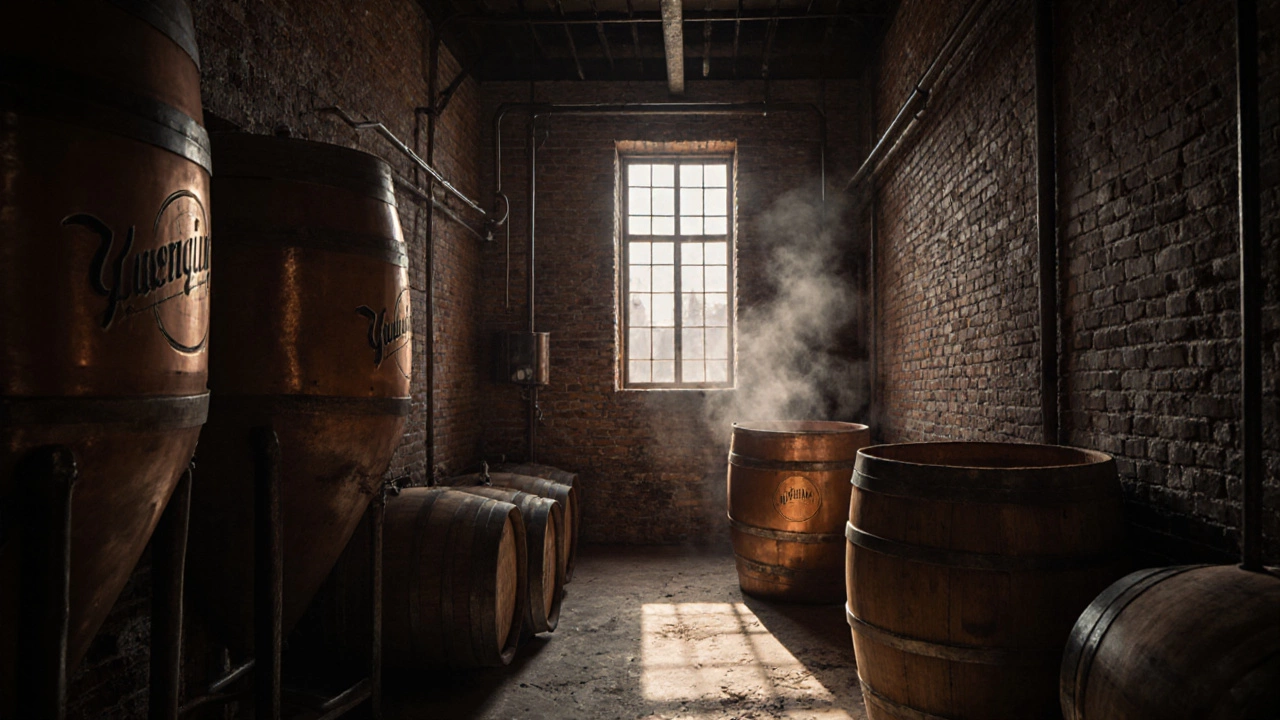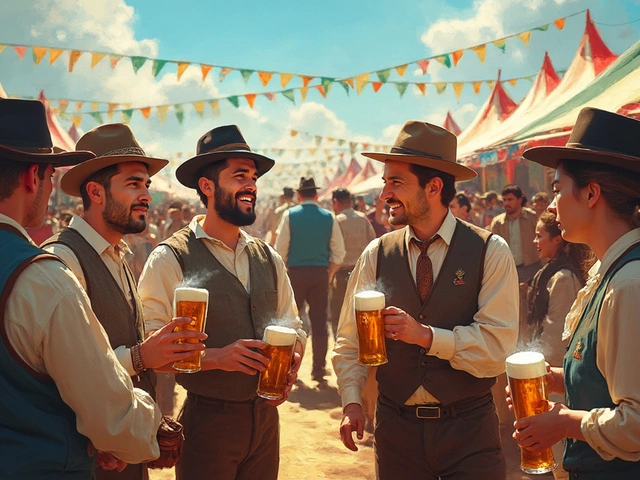Brewery Age Calculator
Calculate Brewery Age
When you hear "America’s oldest brewery," chances are you think of Yuengling. But is that really true? Or is it just a clever marketing line that stuck? If you’ve ever stood in a Pennsylvania bar and heard someone order "a lager," they weren’t just ordering any beer-they were asking for Yuengling. And that’s not by accident. The brand has spent nearly two centuries building a reputation not just on taste, but on survival.
How Yuengling Survived When Others Didn’t
D.G. Yuengling & Son opened its doors in Pottsville, Pennsylvania, in 1829. That’s before the U.S. Civil War, before refrigeration, before the telephone. And yet, it’s still brewing today. What makes that possible? Most breweries from that era vanished during Prohibition. When alcohol was banned in 1920, over 1,300 American breweries shut down for good. Yuengling didn’t just survive-it adapted. Instead of closing, they turned their brewery into a dairy. They made "near beer"-a 0.5% alcohol beverage that skirted the law-and started producing ice cream. That dairy stayed open until 1985. The ice cream returned in 2014, and it’s still sold today. That pivot kept the workforce employed, the equipment maintained, and the brand alive. When Prohibition ended in 1933, Yuengling was ready. They shipped their first post-Prohibition beer to President Franklin D. Roosevelt within hours of the ban being lifted.Why No One Else Can Claim the Title
You might hear about older breweries like Vassar Brewery (1796) or Fraunces Tavern (1763). But they’re gone. Closed. Forgotten. Their buildings are museums or apartments. Their recipes lost. Yuengling is the only one that never stopped brewing. Even if they made ice cream for a while, the brewing equipment never rusted. The yeast cultures stayed alive. The family never sold out. Anheuser-Busch didn’t start until 1852. Pabst came along in 1844. Both are big names now, but they’re younger. And neither stayed family-owned the whole time. Yuengling is still run by the fifth generation-Dick Yuengling Jr.-with the sixth generation (his four daughters) already training to take over. That kind of continuity is rare in any industry, let alone beer.The Numbers Don’t Lie
By 2018, Yuengling was the largest American-owned brewery in the country. They produced about 2.9 million barrels of beer a year. That’s not craft beer volume. It’s not even close. But here’s the twist: they’re still considered America’s oldest brewery, not because they’re the biggest, but because they’re the only one that made it this far without stopping. Their flagship beer, Yuengling Traditional Lager, is an amber lager. It’s not hoppy. It’s not bitter. It’s smooth, slightly sweet, and easy to drink. That’s why it dominates the Mid-Atlantic. In Pennsylvania, it controls over 30% of draft beer sales. People don’t call it "Yuengling." They just say, "I’ll have a lager."
What About Craft Breweries?
Some craft beer fans argue that Yuengling isn’t "real" craft because of its size. And they’re right-it’s not small. But the question isn’t about craft. It’s about history. Craft beer started exploding in the 1980s. Boston Beer Company, makers of Samuel Adams, didn’t even exist until 1984. Yuengling was already 155 years old by then. The Brewers Association, the main trade group for U.S. breweries, officially recognizes Yuengling as the oldest continuously operating brewery. No one disputes that. Even beer historians like Maureen Ogle say Yuengling’s story isn’t just about beer-it’s about resilience. They kept going through wars, economic crashes, and a national ban on alcohol. That’s not luck. That’s strategy.Visiting the Original Brewery
If you’ve never been to Pottsville, you’re missing something special. The original brewhouse from 1831 still stands. Tourists walk through the same cellar where beer aged in wooden barrels. They see the 1930s Rathskeller tasting room, where people drank during Prohibition under the radar. The brewery welcomes over 60,000 visitors a year. Most come for the history, not just the beer. The Tampa facility, opened in 1999, was built to replicate the Pottsville setup exactly. Same copper kettles. Same yeast strain. Same brewing process. That’s how they keep the taste consistent across the country. It’s not just tradition-it’s science. The yeast is over 195 years old. It’s one of the oldest living cultures in the food industry.
Why It Matters Today
In a world of new craft IPAs, hard seltzers, and non-alcoholic beers, Yuengling’s success feels almost rebellious. They didn’t chase trends. They didn’t rebrand. They didn’t go public. They just kept making the same beer, the same way, for nearly two centuries. Their marketing doesn’t shout. It doesn’t use influencers. It just says: "America’s Oldest Brewery." And that’s enough. People believe it. They trust it. They buy it. And they pass it down. Grandparents buy it for their kids. Kids buy it for their friends. It’s not a fad. It’s a family ritual.What’s Next for Yuengling?
They’re expanding. The Tampa brewery got a 20% capacity boost in 2023. They’re now sold in 22 states. But they’re not trying to be everywhere. They’re not competing with Budweiser or Coors on price. They’re competing on legacy. Their six-pack still costs $8-$10. That’s cheaper than most craft beers. And for many, that’s part of the appeal. The real challenge isn’t competition. It’s changing tastes. Younger drinkers want sour ales, hazy IPAs, and low-calorie options. Yuengling doesn’t make those. But they’re not trying to. They’re betting that people still want something real. Something that’s been around longer than their grandparents.Is Yuengling Really the Oldest?
Yes. Without a single doubt. No other brewery in the U.S. has brewed continuously since 1829. No other company has passed from generation to generation without selling to a corporation. No other brand survived Prohibition by making ice cream and kept its yeast alive. It’s not about being the biggest. It’s about being the only one that never quit.Is Yuengling the oldest brewery in the world?
No, Yuengling is the oldest in the United States, but not globally. Germany’s Weihenstephan Abbey has been brewing since 1040. Belgium’s Rodenbach Brewery started in 1821. Yuengling’s claim is strictly American. Outside the U.S., many breweries predate it by centuries.
Did Yuengling really make ice cream during Prohibition?
Yes. After the 1920 Prohibition ban, Yuengling turned its brewery into a dairy and started producing ice cream and "near beer." This kept the business running, kept employees on payroll, and preserved the brewing equipment. The ice cream line was revived in 2014 and is still sold today at the Pottsville visitor center.
Why is Yuengling not sold in all 50 states?
Yuengling has chosen to expand slowly, focusing on the East Coast and Midwest. They prioritize maintaining quality and consistency over rapid national growth. Their distribution strategy is intentional-they want to control how the beer is stored and delivered, especially since they don’t use pasteurization like larger breweries.
Is Yuengling a craft brewery?
By the Brewers Association’s official definition, no-Yuengling produces over 2 million barrels a year, which exceeds the 6 million barrel limit for craft status. But many people still consider it a craft because it’s family-owned, uses traditional methods, and doesn’t outsource production. The debate is more about labels than quality.
What’s the difference between Yuengling Traditional Lager and other lagers?
Yuengling Traditional Lager is an amber lager, not a pale lager like Budweiser or Coors. It’s made with roasted caramel malt, giving it a slightly sweet, toasty flavor and a deep amber color. Most mass-market lagers are light and crisp. Yuengling is fuller-bodied, with a richer mouthfeel and a more complex taste profile. It’s designed to be sipped, not chugged.
Can you visit the original Yuengling brewery?
Yes. The Pottsville, Pennsylvania facility offers guided tours year-round. Visitors see the original 1831 brewhouse, the Prohibition-era cellar, and the 1930s Rathskeller tasting room. The tour ends with a tasting of their flagship lager and seasonal brews. Over 60,000 people visit annually.


